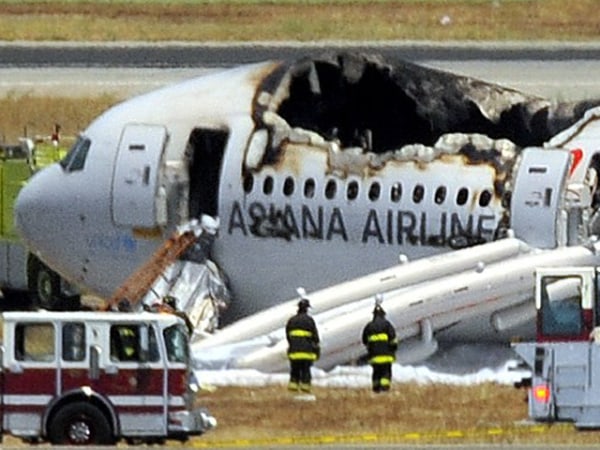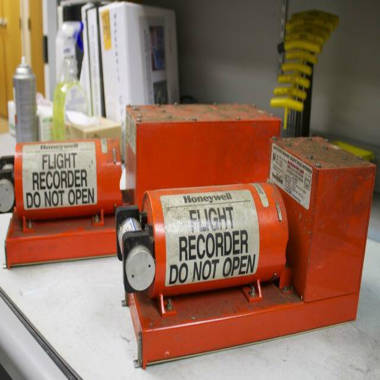
Josh Edelson / AFP - Getty Images
A Boeing 777 operated by Asiana Airlines crash landed at SFO.
By Julie Yoon, F. Brinley Bruton and Matthew DeLuca, NBC News
Investigators recovered both black boxes from Asiana Airlines Flight 214 on Sunday, NTSB officials told NBC News, as the airline?s president said that engine failure was likely not the cause of the crash that killed two and injured scores more on the runway at San Francisco International Airport.
The black boxes from the aircraft, which record critical in-flight data, were recovered from the wreckage and were transported for examination on Sunday, the officials from the National Transportation Safety Board said. Investigators from the NTSB will analyze both the cockpit voice recorder and flight data recorder for clues as to what went wrong. The black boxes from the relatively new plane could potentially contain thousands of data points about the plane's behavior before the crash.

NTSB
NTSB's Greg Smith with flight data recorder and cockpit voice recorder from Asiana 777 in NTSB's DC lab.
The two deceased passengers were identified as Chinese women in their teens, airline president Yoon Young-doo said at a press conference in Seoul, South Korea, on Sunday. The official Weibo microblog account for Asiana identified the victims as Ye Mengtuan and Wang Linjia, both 16 years old. The two were students at Jiangshan Middle School, according to the airline.
?We think there was no engine defect,? Yoon said.
A team of NTSB investigators will have its first full day on the ground Sunday, and will collect evidence and document the site of the crash that ?could have been much worse,? board Chairman Debbie Hersman told Meet the Press. The recovered black boxes could yield important insights within the next 24 hours at the board?s lab in Washington, D.C., she said, where they were transported on a late-night flight under federal guard.
A photograph published on the NTSB?s official Twitter account showed Hersman and Bill English, the investigator-in-charge, looking at the charred interior of the aircraft where collapsed luggage containers and other equipment hung from the ceiling.
?We have a lot of information to go through, and I think at this point everything is still on the table for us,? Hersman said. ?We have to not only identify what we?re focused on, but also to rule things out, and to do that we need good evidence.?
While the NTSB was working in conjunction with the FBI, Hersman said that there was still ?no indication? that any criminal activity was involved in the crash.
More than 180 people were transported to area hospitals after the crash landing that left debris strewn across the runway and ripped open the plane?s tail.
Of the 291 passengers and 16 crew members on board at the time of the crash, 49 incurred serious injuries including fractures and burns and were taken to one of nine Bay Area hospitals. The injured ranged in age from 20 to 76 years old.
?We are very sorry for the pain to the families and passengers,? Asiana chief executive Yoon said on Sunday.

NTSB
Asiana flight data recorder, left, and cockpit voice recorder, right, in NTSB's Washington lab.
Passenger Benjamin Levy said he heard screams after the crash landing, and for a few moments, confusion filled the cabin.
"It was surreal," Levy told NBC Bay Area on Saturday, shortly after being taken by ambulance from San Francisco International Airport. ?"A lot of people screaming and not really believing what has happening to them. I wasn?t believing it either."
Get more local coverage of crash on NBC Bay Area
Among those who made it to safety were 34 Chinese high school students and a teacher, on their way to summer camp in the United States, according to Chinese state television.
The crash ? the first involving a jumbo jet in the United States in more than a decade ? happened at 11:27 a.m. local time. It left a field of debris down the runway, beginning at the seawall that divides the runway from San Francisco Bay. Pieces of the tail could be seen among the wreckage.
As the plane approached the runway from the waters of San Francisco Bay, travelers in the terminals and others eyewitnesses could see that the aircraft was swaying unusually from side to side and that at one point the tail seemed to hit the ground before breaking off.
Tom Costello and Chairman of the NTSB, Debbie Hersman discuss the latest developments on the crash landing in San Francisco.
Despite the deaths and scores of injuries -- many of them serious -- San Francisco Mayor Edwin Lee said at a Saturday evening news conference that "This could have been much worse."
Federal investigators said on Saturday that it was too early to determine a cause. A representative of the National Transportation Safety Board arrived on scene late Saturday and took control of the investigation.
Sources who spoke with NBC News said the pilot did not make a distress call before landing. The plane crashed in favorable weather ? partly cloudy skies and light wind.
A San Francisco airport spokesman said that a component of the facility's instrument landing system that tracks an incoming airplane's glide path was not working on Saturday.
Pilots and air safety experts said the glide path technology was far from essential for a safe landing in good weather.
Kevin Hiatt, chief executive of the Flight Safety Foundation and a former Delta pilot, said it was common for airports to take instrument landing systems offline for maintenance on clear days. Pilots use several other instruments and visual cues to land in clear conditions, Hiatt said.
The fiery crash landing of a Korean jetliner at the San Francisco International Airport late Saturday morning has left at least two people dead, and up to 70 injured, according to NBC Bay Area station KNTV. Hospitals say some of the injured are critical. NBC's Lester Holt reports.
"All of those are more than adequate to fly an aircraft down for a successful landing on the runway," he said.
Stefanie Turner, a witness, told MSNBC that she saw the plane clip the runway with its tail, then come to rest with flames and smoke billowing from the fuselage.
?The tail was too low. Instead of coming in flat it was coming in at, I would say, maybe a 45-degree angle, with the tail far too low,? she said.
?It really went through quite a few acrobatics on the runway.?
The jet carried 141 Chinese, 77 Koreans, 61 Americans, three passengers from India, one each from Japan and Vietnam and seven whose nationalities were unknown, the airline said. A situation room was set up in Beijing to provide information and help to the families of Chinese passengers, Yoon said.
NBC News'?Erin McClam, Emma Ong, Daniel Arkin,?Julie Yoo, Le Li, Jay Blackman, Jonathan Dienst, Richard Esposito, Tracy Jarrett and Kristen Welker contributed to this report. The Associated Press and Reuters also contributed.
San Francisco Mayor Edwin Lee thanks the first responders of the Asiana Airlines crash and says "this could have been much worse."
Related:
?
This story was originally published on Sun Jul 7, 2013 10:35 AM EDT
Espn Bracket First Day Of Spring 2013 Bates Motel Michelle Shocked ncaa bracket bracket Jason Terry
No comments:
Post a Comment
Note: Only a member of this blog may post a comment.